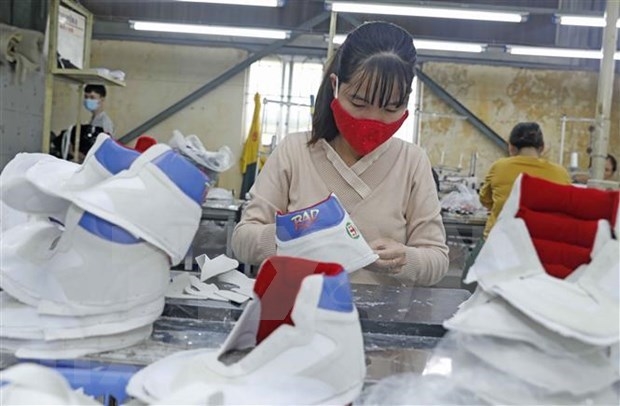Footwear industry must implement green development to gain growth targets: Experts
Thursday, June 22,2023
AsemconnectVietnam - The footwear industry must implement solutions on sustainable development to fulfil the goals in a development strategy for Vietnam's garment-textile and footwear industries to 2030, with a vision to 2035, according to experts.
This development strategy sets the goal of turning Vietnam into a country that produces export textiles, garments and footwear, meeting requirements for sustainable development.
Vietnam also targets to reach a total export turnover of footwear and handbags of 38-40 billion USD by 2030. The industry by 2035 will have sustainable development according to the green economy model, complete the domestic production value chain, and effectively participate in the global value chain. It will develop a number of regional and world brands.
Diep Thanh Kiet, Vice Chairman of the Vietnam Leather, Footwear and Handbag Association (LEFASO), said that to achieve the goals of the strategy, Vietnamese leather and footwear enterprises must focus on the standards of sustainable development.
When the EU's carbon border adjustment mechanism (CBAM) comes into effect, Vietnamese enterprises cannot export to Europe if their products do not satisfy CBAM's criteria, even if these products meet the requirements under the EU-Vietnam Free Trade Agreement (EVFTA).
At the same time, enterprises must develop their ability to design products and reduce production costs to the lowest level.
Meanwhile, the Government needs to issue policies on encouraging localisation of raw materials, and implementing the standards on sustainable development.
According to Nguyen Ngoc Hoa, Chairman of the HCM City Union of Business Associations (HUBA), the development of a green economy is mandatory not only for businesses but also for the whole economy.
Sustainable development is not a burden, but an investment in opportunities for business in the future. Some businesses have received many orders after complying with the green production process.
Senior economist Nguyen Minh Phong said the domestic carbon credit market would pilot operation from 2025 and operate officially in 2028 under international commitments. This market promises to create an impetus for Vietnamese businesses to move towards low-emission production. Enterprises with great emission reduction potential at low cost could immediately invest in converting to emission reduction technologies.
According to the observation of Maxime Rogeon, head of the Footwear Team, at Decathlon Vietnam, Vietnam has many advantages, such as large export markets thanks to FTAs and domestic material supply at 50% of demand. Besides that, almost all of the world's major footwear manufacturers have developed production facilities in Vietnam. However, this country needs solutions for green logistics, sourcing and faster shipping.
Vietnam's leather and footwear industry also needs policies to encourage the application of artificial intelligence technology in production.
Additionally, Vietnam needs to restructure the footwear industry and apply sustainable production and business models that save production costs.
Le Hung Cuong, Digital Director of FPT Digital, a subsidiary of FPT Corporation, recommended that footwear businesses needed to participate in shared ecosystems, thereby taking advantage of big data.
The digital transformation process needs to ensure safety for company data but also customer data, according to Cuong.
Businesses also need to pay attention to optimising customer experience and interactions for all stages of the business process.
At present, about 65% of Vietnam's footwear production capacity is concentrated in the Southeast region. The percentage is 16% in the Red River Delta; 15% in the Mekong Delta; 3% in the North Central and Central Coast regions; and 1% in the Northern mountainous region.
Of which, the Southeast region and the Mekong River Delta have a tendency to reduce production capacity. The North Central Coast, Central Coast and Mekong River Delta are on an increasing trend.
Therefore, businesses and investors should pay attention to these trends if they want to expand production, otherwise, it will not be easy to find workers, according to experts.
Kiet said LEFASO had developed an export scenario for 2023. In the optimistic scenario, production will recover from the third quarter, and the footwear industry's export turnover is expected to reach 25.8 billion USD this year, down 7.5% compared to last year.
In another scenario, production will be restored in the fourth quarter of 2023. This year's export turnover is expected to reach 25 billion USD, down 10.5% compared to 2022.
In a negative scenario, by the fourth quarter of this year, production has not yet recovered, so the export turnover is predicted to reach 24.4 billion USD, down 14.5% compared to 2022.
Source: Vietnamplus.vn
World Bank: Vietnam’s CPI inflation trends down for fourth month
SBV’s policy rate likely to drop to 4%: HSBC
Exports to UK reached 2.3 billion USD in first 5 months of 2023
Rice exports increased by 41.6% in turnover in first 5 months of 2023
Fertilizer imports decreased in first 5 months of 2023
Reference exchange rate up 21 VND
Thai retailers advised to effectively exploit Vietnamese market
Average payments via banks reach 40 billion USD a day: insider
DAILY: Vietnamese pepper prices remained unchanged on June 19
Reference exchange rate down 14 VND at week’s beginning
DAILY: Vietnamese coffee prices remained unchanged on June 19
Green, circular agricultural production boosts exports
Vietnamese seedless lychees now available in UK market
Seafood exports reached nearly 3.38 billion USD in first 5 months of 2023

Plan on implementing national strategy on climate change ...
Actively and effectively adapting, reducing vulnerability, loss and damage due to climate change; reduce greenhouse gas emissions ...Scheme on attracting, restructuring and improving quality ...
Urban development plan of Binh Phuoc province in a period ...
Plan on implementing Decision No. 327/QD-TTG dated March ...

Hung Kings Temple Festival 2023 kicks off
The Hung Kings Temple Festival 2023 and the Culture and Tourism Week of Ancestral Land 2023 kicked off in the northern province of Phu Tho ...Vietnam trounce Palestine at AFC U-17 Women's Asian ...
Phu Tho: Festival honours UNESCO intangible cultural ...
Saigontourist Group Food and Culture Festival 2023 opens
Vietnam’s top swimmer Huy Hoang to hold Vietnamese flag at ...



